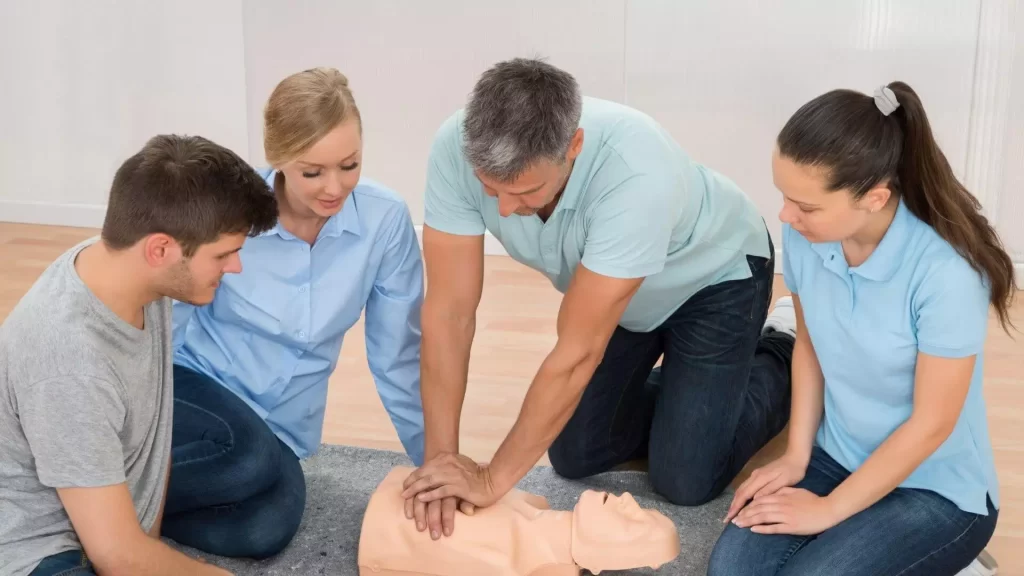Cardiopulmonary Resuscitation (CPR) is a vital first aid technique that can save lives during emergencies. Imagine having the power to restore someone’s heartbeat and breathing when every second counts. In this blog post, we will unravel the mystery behind CPR, explaining its significance in simple terms and providing you with an easy-to-follow guide on how to perform it effectively. Get ready to become a superhero of life-saving skills!
Content
How Does CPR Work?
Cardiopulmonary Resuscitation (CPR) is a life-saving technique that helps restore blood circulation and oxygen supply to the body when someone’s heart has stopped beating. Understanding how CPR works can empower you to take immediate action during an emergency.
The Basic Principles of CPR
When performing CPR, there are two main components: chest compressions and rescue breaths. The goal is to mimic the natural pumping action of the heart and maintain airflow into the lungs.
1. Chest Compressions Chest compressions involve applying rhythmic pressure on the chest using your hands. This action helps circulate oxygenated blood throughout the body, delivering vital nutrients to organs and tissues.
- Place your hands in the center of the victim’s chest.
- Position yourself directly over their chest, with straight arms.
- Push down hard and fast at a rate of around 100-120 compressions per minute.
2. Rescue Breaths Rescue breaths involve providing artificial ventilation by blowing air into the victim’s lungs, replenishing their oxygen levels.
- After performing 30 compressions, give two rescue breaths.
- Tilt their head back slightly while lifting their chin forward for proper alignment.
- Pinch their nose shut and create an airtight seal over their mouth with yours.
- Give a breath lasting about one second until you see their chest rise visibly.
Even if you’re unable or uncomfortable giving rescue breaths, continuing high-quality chest compressions alone can still make a significant difference in saving lives! Remember, according to the American Safety and Fitness Institute (ASFA), hands-only CPR is an effective technique that increases the chances of survival during emergencies.
Step-by-Step Guide to Performing CPR
When faced with a cardiac emergency, knowing the steps to perform CPR can make a life-saving difference. By following this step-by-step guide, you’ll be prepared to act confidently and effectively in such critical situations.
1. Assessing the Situation and Ensuring Safety Before starting CPR, assess the scene for any potential dangers that could harm both you and the victim. Ensure safety by removing hazards or moving the person to a safer location if possible.
2. Checking Responsiveness and Calling for Help Gently tap the victim’s shoulder and shout loudly asking if they’re okay. If there is no response, immediately call emergency services or ask someone nearby to do so while you provide assistance.
3. Opening Airways To open airways, use either of these techniques:
- For suspected spinal injuries: Perform a jaw thrust maneuver by placing your hands on either side of their face near their ears and gently lift their jaw forward without tilting their head.
- Otherwise: Use the head tilt-chin lift technique by placing one hand on their forehead while using two fingers from your other hand under their chin; then gently tilt back their head.
4. Initiating Chest Compressions Position yourself correctly:
- Kneel beside them close enough that your shoulders align with their chest. Place your dominant hand’s heel at the center of their chest (between nipple line). Interlock your non-dominant hand over it. Keep elbows straight but not locked; position shoulders directly above hands.
Push hard (about 2 inches) at a rate of around 100-120 compressions per minute—letting chest fully recoil between each compression—for maximum effectiveness.
5. Delivering Rescue Breaths After every 30 compressions: Pinch victim’s nose shut; make an airtight seal covering mouth with yours. Deliver breath lasting about one second, watching for visible chest rise. Resume compressions immediately.
6. Continuing Cycles of Compressions and Breaths Repeat cycles until medical professionals arrive or signs of life return:
- Aim for a compression-to-breath ratio of 30:2 (with minimal interruptions).
- Ensure proper hand placement during ventilations to maintain effectiveness.
Remember, don’t give up easily—your efforts can greatly increase the chances of survival!
Common Misconceptions About CPR
When it comes to Cardiopulmonary Resuscitation (CPR), there are several misconceptions that can cloud our understanding of this life-saving technique. Let’s debunk some common myths and set the record straight.
Addressing Common Myths Associated with Performing CPR
One prevalent misconception is the belief that performing CPR alone can bring someone back to life instantly, like in the movies. In reality, CPR aims to maintain blood circulation and oxygen supply until professional medical help arrives.
Another myth revolves around the rhythm for chest compressions during CPR. Contrary to popular belief, you don’t have to perfectly match your compressions with the beat of songs like “Stayin’ Alive” by the Bee Gees or “Dancing Queen” by ABBA. While these songs provide a rough guide for maintaining an appropriate pace, focusing on delivering effective compressions at a rate of 100-120 per minute is more important than finding a specific musical rhythm.
It’s crucial not to be misled by such misconceptions when it comes to performing proper CPR techniques. Staying informed about accurate procedures ensures that you’re equipped with reliable knowledge in emergency situations.
By dispelling these myths surrounding CPR, we pave the way for better understanding and implementation of this vital life-saving skill.
Conclusion
In conclusion, CPR (Cardiopulmonary Resuscitation) is a crucial life-saving technique that empowers individuals to become heroes in emergency situations. By understanding the basic principles and following the step-by-step guide we’ve provided, you can make a significant difference in someone’s chance of survival. Don’t wait—get trained and be prepared to save lives!
FAQs
Is CPR the same as basic first aid?
No, CPR (Cardiopulmonary Resuscitation) is a specific life-saving technique used to restore blood circulation and breathing when someone’s heart has stopped. Basic first aid encompasses a broader range of skills for providing immediate care during various emergencies.
Can anyone perform CPR, or do I need special training?
While it’s recommended that everyone learns CPR, proper training from certified organizations like the American Heart Association (AHA) or Red Cross ensures you have the knowledge and skills to perform effective CPR correctly.
Should I always give rescue breaths during CPR?
Rescue breaths are an essential component of traditional CPR techniques; however, hands-only compressions can still be effective if you’re unable or uncomfortable giving rescue breaths. The important thing is to provide high-quality chest compressions without interruption.
How deep should my chest compressions be during CPR?
During adult CPR, aim for compressions with a depth of about 2 inches (5 centimeters). This allows sufficient blood flow through the body while minimizing potential injury.

Carl Clay is a health blog author who has been writing about nutrition, fitness and healthy living for over 10 years. He also loves to run, hike and bike with her wife.













